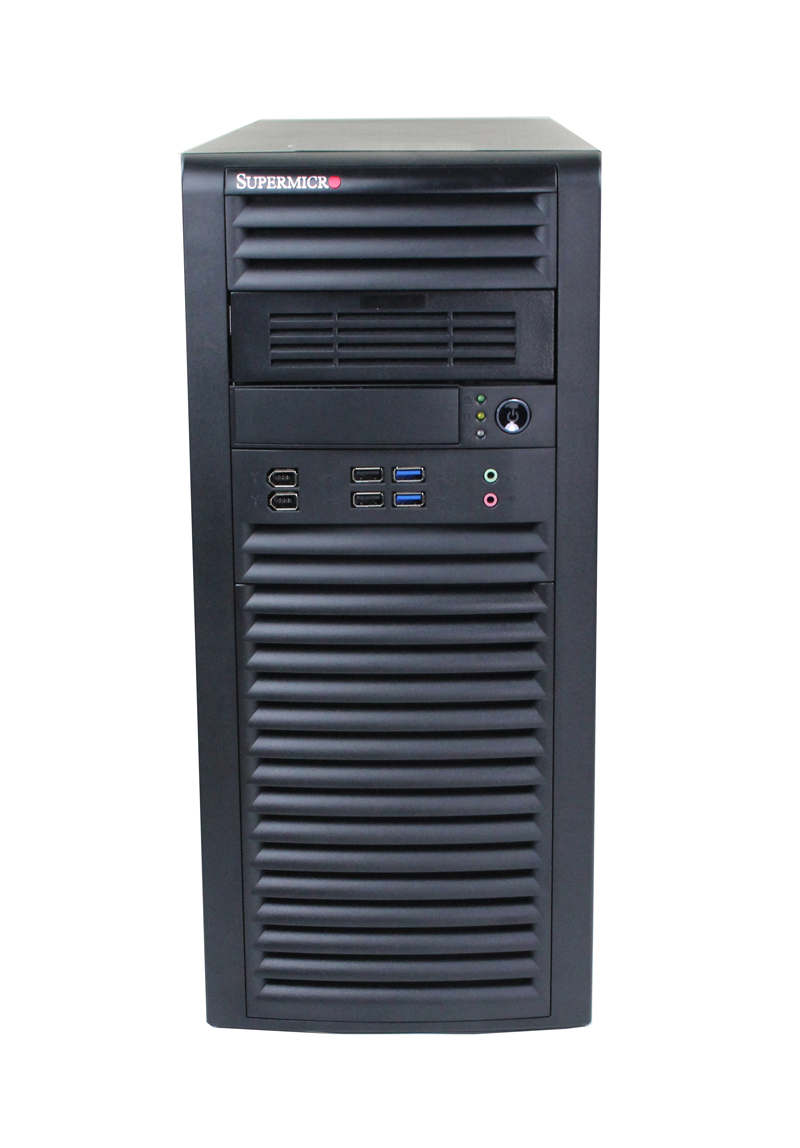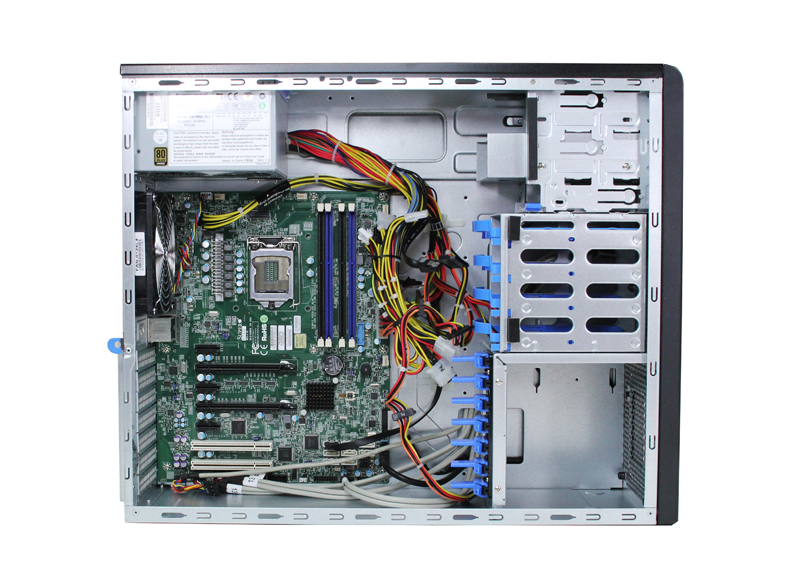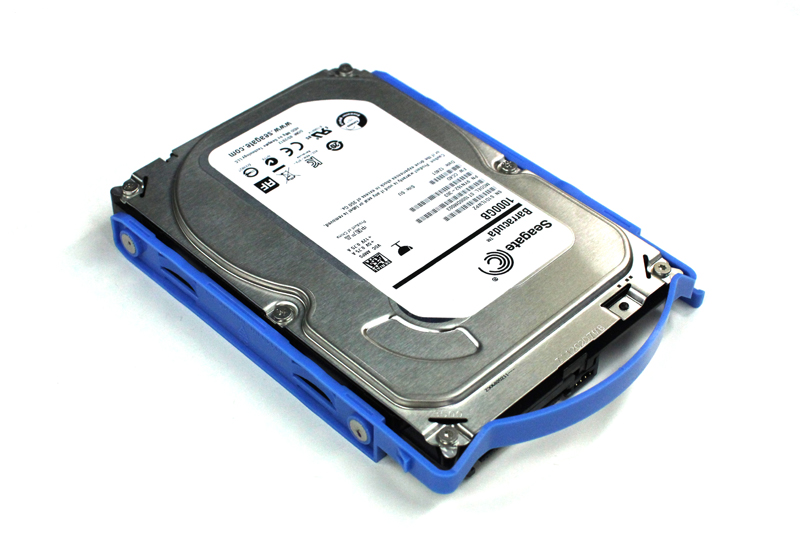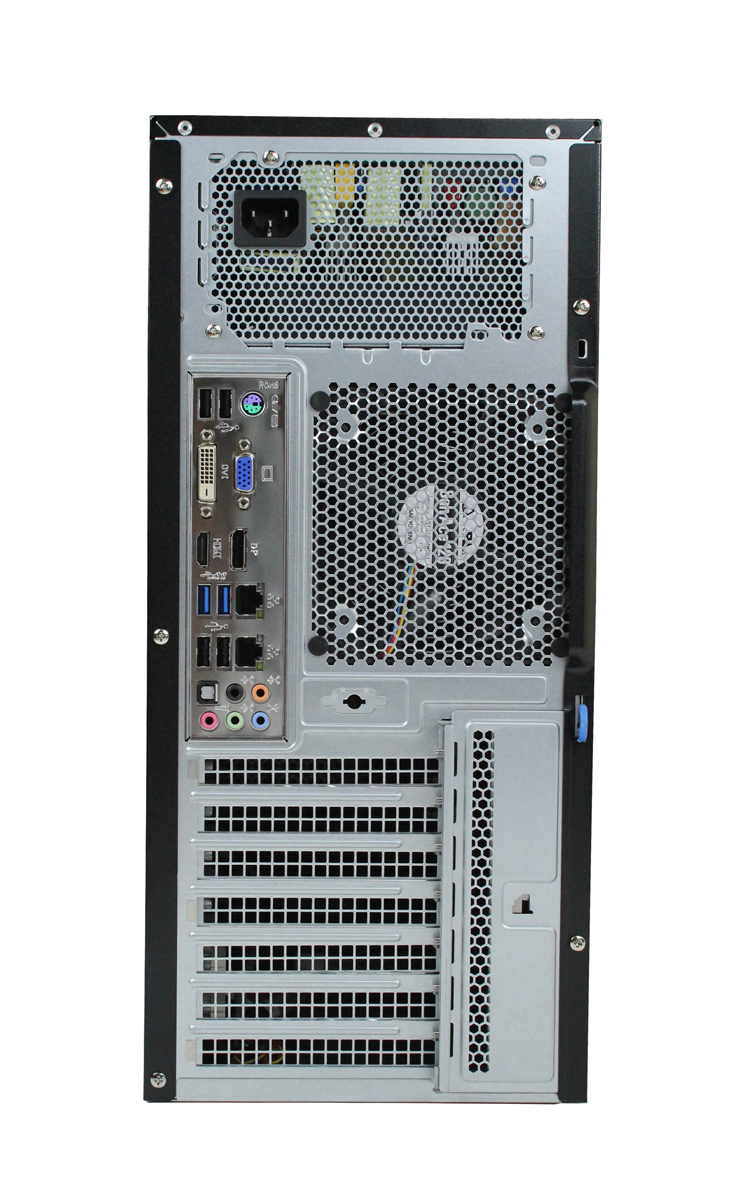Haswell-Based Xeon E3-1200: Three Generations, Benchmarked
Supermicro SuperWorkstation 5038A-iL: Our LGA 1150 Test Platform
Since Intel keeps its Haswell-based platforms fairly stable in terms of interface size, memory configurations, PCI Express support, the motherboards look pretty similar (aside from the power circuitry integrated onto the die). Consequently, many vendors had little trouble updating their previous-gen products. This goes for Supermicro's SuperWorkstation 5038A-iL. As you can probably guess from the incremented model number (5038 versus 5037), this is an updated platform.
The chassis is a lot like what we saw from the 5037A-iL. Looking at the front, there are some obvious changes. Up front, we still have two USB 3.0 and two USB 2.0 ports, along with an audio interface. That I/O is augmented by two FireWire connectors on the updated case. Our test unit came with a 5.25" bay adapter, which you can see in the second external bay from the top.
Inside is Supermicro's X10SAE motherboard. This is where you'll find some of the most notable changes. For instance, the memory configuration is now top to bottom, which is more typical of consumer motherboards. That'd be a major change on a passively-cooled server board. But for the workstation-oriented X10SAE, it works fine.
In the newest generation, Ethernet comes from Intel's i217LM and i210AT controllers. This is notable because Intel is transitioning its customers to newer silicon. The i217LM is found on C226-based platforms, while the i210 succeeds Intel's 82574L. We've already seen a lot of Haswell-based server boards with these controllers. You may not find drivers built-in to your operating system, but support for most environments is at least available from Intel.
Supermicro enables eight SATA 6Gb/s ports, compared to the previous version's two 6 Gb/s and four 3 Gb/s connectors. Six of those ports are tied to Intel's PCH, while the other two come from ASMedia's ASM1061 on-board controller. The key takeaway is that there are more higher-throughput ports, which is a good thing from a workstation. We also find the same toolless 3.5" drive sleds that were available from the LGA 1155 platform.
Audio gets upgraded to Realtek's ALC1150. As with its predecessor, the X10SAE includes optical S/PDIF connectivity.
Expansion includes two third-gen PCIe x16 slots that either run at 16x/0x or 8x/8x, three PCIe 2.0 links in x4 slots, and two 32-bit PCI slots. The X10SAE's support for two x8 links lets you hook up high-end SAS card or a second GPU. That second PCI slot is interesting too; it may have been added due to other PCIe-based controllers that were already deployed on-board.
Get Tom's Hardware's best news and in-depth reviews, straight to your inbox.
Rounding out the board's feature set is support for six USB 3.0 ports and up to 10 USB 2.0 connectors. Both generations accommodate two additional ports compared to the X9SAE model. The X10SAE has eight fan headers that can control speeds based on thermal readings and target acoustics. A 128 Mb EEPROM with AMI firmware is twice as large as the X9SAE.
The bottom line is this: the X10SAE is an upgraded platform that adds faster interface speeds and support for LGA 1150.
Current page: Supermicro SuperWorkstation 5038A-iL: Our LGA 1150 Test Platform
Prev Page Supermicro SuperWorkstation 5037A-iL: Our LGA 1155 Test Platform Next Page Hardware Setup And Benchmarks-
dgingeri I have two Dell T110 II servers, one with an E3-1230 and one with an E3-1220v2, that cost me less than $800 each. I can tell you, they are great little machines, perfect for self-teaching Windows Server or ESXi. I now have the E3-1220v2 set up as my Windows 2008r2 router/DNS/DHCP/file/print server, and it uses a mere 45W of power when idle. The E3-1230 is my ESXi 5.1 machine right now.Reply -
CommentariesAnd More Best article to say in your face to those who think Xeons are poor performers.Reply -
vmem honestly not surprising at allReply
I think 'meh' will be the overwhelming majority consensus on this chip -
g-unit1111 Reply11571644 said:honestly not surprising at all
I think 'meh' will be the overwhelming majority consensus on this chip
That's kind of the way I see it. I don't think the Xeon is anything to write home about like some people on this board do, but the average user and/or gamer won't notice a lick of difference between an i5, i7, and low end Xeon. I would only recommend them in instances of things like Photoshop and heavy duty CS5 usage, but even then an i7-4770K or i7-4820K would be a better choice. -
InvalidError While ARM chips may be doubling performance on a fairly regular basis, you need to keep in mind that ARM chips are starting from pretty far back. By the time they catch up with mainstream x86 chips, they will most likely hit very similar IPC and frequency scaling brick walls as x86 chips and won't gain much ground beyond that.Reply
The only real threat from ARM is to profit margins: once ARM catches up, it may become more difficult for Intel to maintain the large premiums they currently command across most markets. -
the1kingbob Did Toms looks at the AMD 6100, 6200, and 6300? That would make to be an interesting comparison since the underlying architecture changed from the 6200 to 6300 (i think, maybe 6100 to 6200)Reply -
Amdlova people in my county buy this processor for gaming... need a seriosly test on this. 1230v2 have same price 3570k here!Reply -
dgingeri "I would only recommend them in instances of things like Photoshop and heavy duty CS5 usage, but even then an i7-4770K or i7-4820K would be a better choice." They wouldn't be any advantage in either case. The advantage of the Xeon isn't performance, but stability. It's use of ECC memory makes it much better for purposes like a high end workstation for an engineer or digital artist so their work isn't lost or interrupted by a memory error and crash or in servers where it can stay running reliably for months at a time.Reply
In addition, the chipsets and platforms used with Xeons are more stringently held to industry standards, making them known quantities for device makers. Enterprise raid controllers are frequently unsupported on a standard desktop system with a Core i7 4770 and Z87 chipset, while they would be supported on a Xeon E3-1275v3 with a C226 chipset, even though the actual silicon design is exactly the same between the two.
There really isn't any difference in the silicon itself between a Haswell Core i7 and a Haswell Xeon E3, so there won't be a performance difference. The difference is in the stability of equipment surrounding each. -
pjkenned InvalidError - these are not in the same league as the ARM chips. Avoton and Rangeley are the real ARM competitor. I JUST got two Avoton 8-core platforms in the lab as this article was going live (benchmarks here: http://forums.servethehome.com/processors-motherboards/2444-intel-avoton-c2750-benchmarks-supermicro-a1sai-2750f.html ) If ARM was targeting Centerton (the Atom S1260), they are targeting a platform way behind Avoton and the E3 reviewed above.Reply
the1kingbob - I have AMD Opteron 3000, 4000 and 6000 series chips in the lab and use them daily. The Operton 3300 series would be the closest platform but the performance is significantly behind the Haswell Xeon E3-1275 V3. Those Opterons also do not have integrated GPUs like the E3-12x5 V1 V2 and V3 chips so are hard to compare. -
InvalidError Reply
And I never said they were - at least for now. But ARM might get there if they manage to sustain their current improvement pace for a few years while AMD and Intel remain stuck for most intents and purposes.11572444 said:InvalidError - these are not in the same league as the ARM chips.
Yes, Intel released some cut-down x86 chips to compete with ARM for low-power market segments but this is only a temporary fix since Intel will likely add much of that stuff back in to keep up with ARM as ARM performance ramps up. The interesting part in 3-5 years will be where ARM will go once they hit the same steep diminishing return slope AMD and Intel are on.



